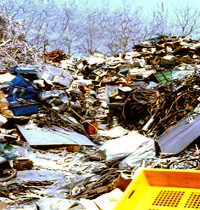With rapid advances in technology, computer, and other tech toys have a shelf life of no more than a few years. This means that "e-waste" or "tech trash" is on a frightening rise. The EPA says Americans recycled 34,000,000 (million) pounds of e-waste last year, but most of it still ends up in a landfill, or remains in the garage, as people don't know where to turn.
From the illegal dumping of hazardous waste in foreign countries to selling old hard drives to identity thieves, recycling an old computer today raises a myriad of concerns. When combined with other forms of electronic, or e-waste - cell phones, TVs and cameras -1.3 billion pounds of materials were recycled that year. A good deal of that poundage could produce diesel.
An old computer monitor or TV set contains an average of 4 pounds of lead, according the federal Environmental Protection Agency. Other electronics devices, including desktop computers can contain chromium, cadmium, mercury, beryllium, nickel, and zinc. How these elements are extracted is coming under increasing scrutiny and concern.
Mike Wright, president of Guaranteed Recycle Xperts, a Denver-based electronics recycler says:
In the past, the solution has been to fill containers with unwanted equipment and ship it overseas to a third world country where lax environmental laws allow low-wage workers to violently disassemble them to get to the parts that have value.
He said that burning or acid bath techniques used to cull precious elements like copper from wires, gold and platinum from motherboards, etc., produce harmful, if not deadly, toxins—often these toxins end up in the soil or rivers while furans and dioxins permeate the atmosphere. This black, perpetual twilight over Shanghai and the Guangzhou corridor eventually rises to the jet stream, that flows east across the Pacific toward United States.
Investigators who visited the waste sites in Guiyu, China, in December saw men, women and children pulling wires from computers and burning them, fouling the air with carcinogenic smoke.
 Three of the five major tributaries in China are totally polluted, running black with chemicals, dyes, hydrocarbons and untold other contaminants; more than 190 times the pollution levels allowed under World Health Organization guidelines. The average 8-year-old child hired to attack these e-carcasses is afflicted with lead poisoning, tuberculosis, and carries gross skin lesions.
Three of the five major tributaries in China are totally polluted, running black with chemicals, dyes, hydrocarbons and untold other contaminants; more than 190 times the pollution levels allowed under World Health Organization guidelines. The average 8-year-old child hired to attack these e-carcasses is afflicted with lead poisoning, tuberculosis, and carries gross skin lesions.
A new report documents one such "cyber-age nightmare" . . . a cluster of villages in southeastern China where computers still bearing the labels of their one-time owners in America are ripped apart and strewn along rivers and fields.
It is actually illegal to ship e-waste to certain countries, such as China, Wright said. Still, a large number of devices are being sent to traditional landfills, where moisture will erode parts of the device, washing lead and other harmful materials into the watershed. Electronic waste is growing in landfills three times faster than other types of waste.
A sizable CC unit at major city landfills, or on a dedicated plot, could conceivably devour this humongous amount of plastic casings safely and without emissions nor health problems.
While it is the right of a sovereign country to dictate their own affairs, it needs to be ethically addressed while an intrinsic member of a planet. Your large oak tree can hang over my fence an drop acorns in my yard.


 Three of the five major tributaries in China are totally polluted, running black with chemicals, dyes, hydrocarbons and untold other contaminants; more than 190 times the pollution levels allowed under World Health Organization guidelines. The average 8-year-old child hired to attack these e-carcasses is afflicted with lead poisoning, tuberculosis, and carries gross skin lesions.
Three of the five major tributaries in China are totally polluted, running black with chemicals, dyes, hydrocarbons and untold other contaminants; more than 190 times the pollution levels allowed under World Health Organization guidelines. The average 8-year-old child hired to attack these e-carcasses is afflicted with lead poisoning, tuberculosis, and carries gross skin lesions.